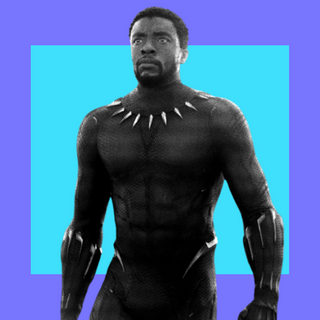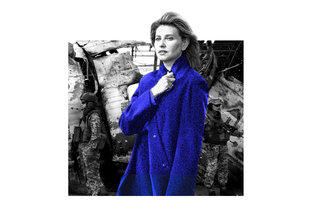
What Are the Ethics of Fashion Magazines Using War‑Zones as a Backdrop?
Vogue’s cover with Ukrainian First Lady Olena Zelenska stirs questions about the role of fashion magazines in cultural conversations about war.

This week, fashion behemoth Vogue published a cover story that featured Ukrainian First Lady Olena Zelenska looking somber against a backdrop of sandbags and once-ostentatious marble pillars. In the magazine itself, more photos follow. One that particularly stands out is where, controversially, Zelenska poses in a navy blue coat over a long dress against the ravages of war in the country.
But July 26th is not the first time Vogue aestheticized a crisis. In 2010, the magazine featured model Kristen McMenamy drenched in and surrounded by slick, black oil — a response to the devastating Gulf oil spill at the time. But perhaps the most enduring photograph is one from June 1941. Titled ‘Fashion Is Indestructible,’ the black and white photo shows a woman immaculately dressed in a suit, standing in the wreckage of a bombed building.
The Zelenska cover received a divided public response recently: some felt it was a way to capture the emotional toll of the devastating war in Ukraine, while others felt it was romanticizing armed conflict, thereby minimizing its harms. But fashion and war go back a long way, making the debate less straightforward than it seems. “It has been said that as facile of an art as it may at the time seem, fashion paired with journalism holds the power to not only reflect the times but also influence changes (negative or positive), especially in the process of shaping the impressionable minds of an upcoming generation,” NSSMag noted.
Fashion magazines — at one point almost interchangeable with ‘women’s magazines’ and ‘ladies’ journals’ — have had a historic role to play in mediating conflict to a public trying to grapple with the meaning of it. During the Second World War, for instance, Vogue played an instrumental role: editors of the magazine worked with the British Ministry of Information to serve as a channel to talk to the women of the country and implicitly instruct them on their role in the war.
“Women’s magazines had a special place in government thinking during the war because, with men in the forces, women carried the whole responsibility of family life; and the way to catch women’s attention was through the pages of magazines which, in total, were read by almost every woman in the country,” noted Audrey Withers, British Vogue’s wartime editor during WW2. “… every subject in which the intelligent sophisticated woman is currently interested,” Withers wrote in a letter to the American editor-in-chief Edna Chase at the time, about the future of Vogue.
Related on The Swaddle:
Social Media Is Shaping Our Memory of Wars, Pandemic. What Will That Mean for History?
At the height of the Second World War, Withers commissioned Lee Miller, an American model and photographer, to document the war from the frontlines. Miller’s iconography included one picture of herself in Hitler’s bathtub after he fled his own residence — images that showed defiance, resistance, and most crucially, provided not just information but an intellectual form of engagement with politics for women readers of the magazine.
The implicit messaging behind the cover of Zelenska in 2022 is not dissimilar: “The female voices in this war need to be heard, need to be represented… [Zelenska is] the first to speak about the human experience of the war,” Vogue Ukraine’s former editor Tetyana Solovey noted. The cover story itself explores the interiority of the first lady who came to stand in for the war’s emotional nerve center — a world apart from the brusqueness of geopolitical diplomacy.
But there’s more to this issue: the piece also continually highlighted her role as a wife and a mother — casting her at the delicate intersection between vulnerability and resilience and thereby reinforcing gender roles during a loss of control in other domains in the country. Placing her at the heart of the grayness and desolation of war, then, makes for a striking image. Some might argue that this is the point: besides Vogue, other women’s magazines played a crucial role in normalizing gender expectations during the war — informing readers of the war while also emphasizing femininity.
Some commentators then rightfully note that fashion and politics aren’t mutually exclusive — as fashion magazines have at various points of time applied soft power in shaping political conversations among their demographic. When women express interest in fashion, “it is often weaponized as a means of denying [them] access to political conversations,” noted Lauren Duca in Teen Vogue. In 2016, for instance, many fashion magazines got explicitly political in the wake of Donald Trump’s election to the United States’ Presidency.
Even so, a photoshoot amid the ruins of an ongoing crisis feels tonally insensitive at best, and callously offensive at worst. The photoshoot doesn’t capture the frontlines in the way that the Withers issue’s photography did. While fashion magazines and war have shaped a complicated history, there is still a hard line separating photojournalism from photoshoots — with the Zelenskyy cover story falling into the latter category, there is real harm in whitewashing the brutality of the conflict in trying to tell a story about a person rather than the war itself.
Rohitha Naraharisetty is a Senior Associate Editor at The Swaddle. She writes about the intersection of gender, caste, social movements, and pop culture. She can be found on Instagram at @rohitha_97 or on Twitter at @romimacaronii.
Related


Instagram’s Pivot to Video May Forever Turn Our Lives Into Content
